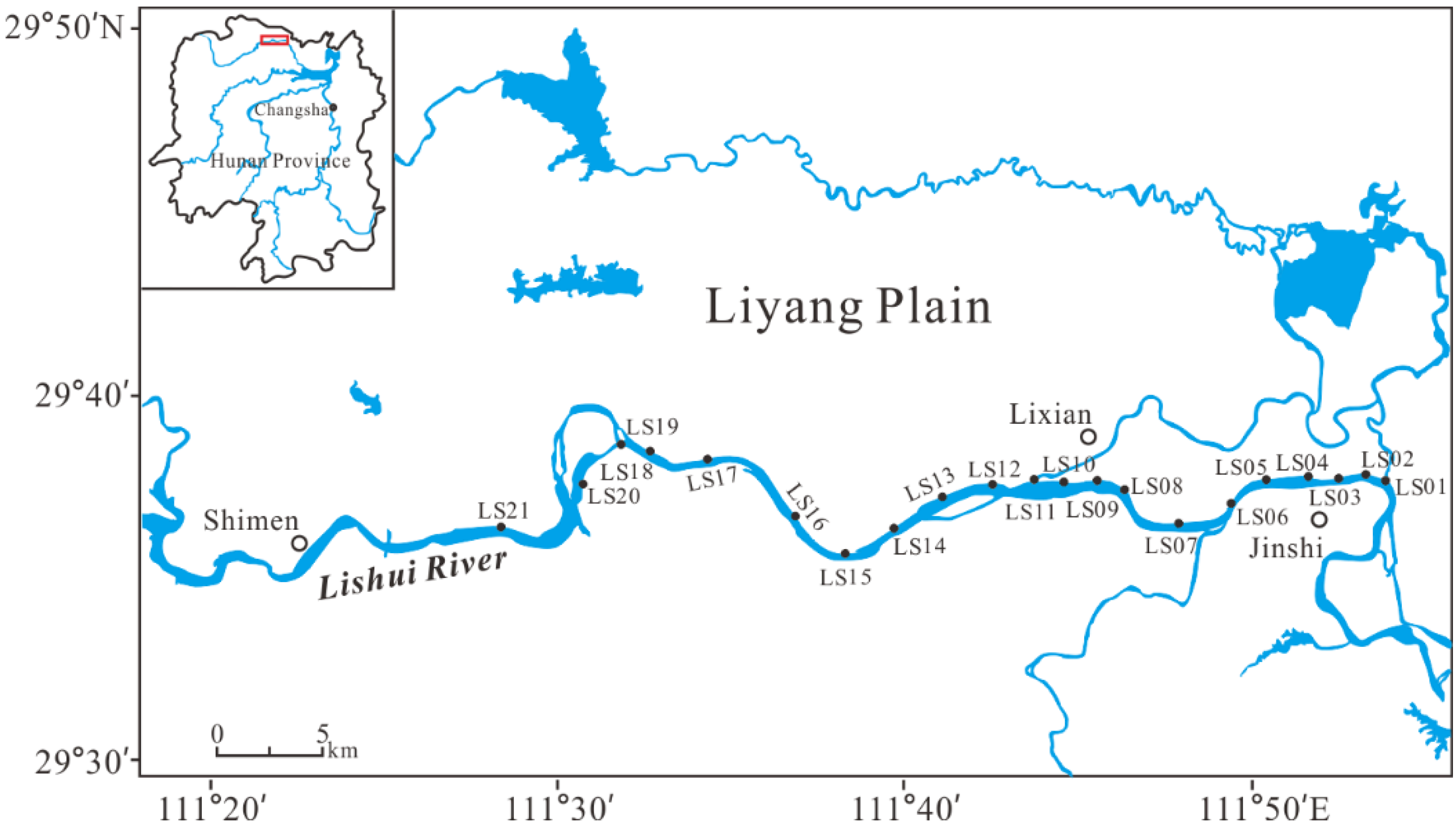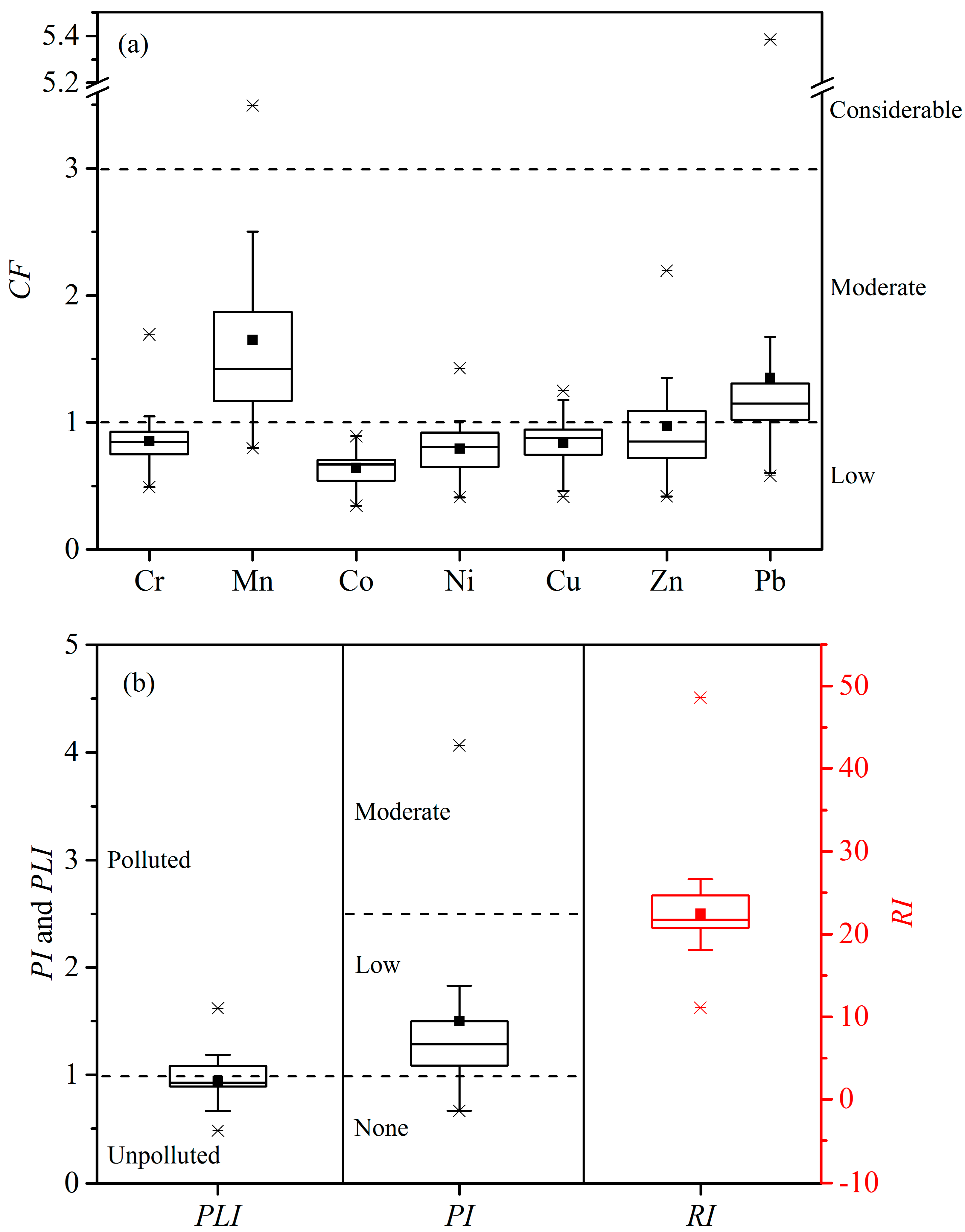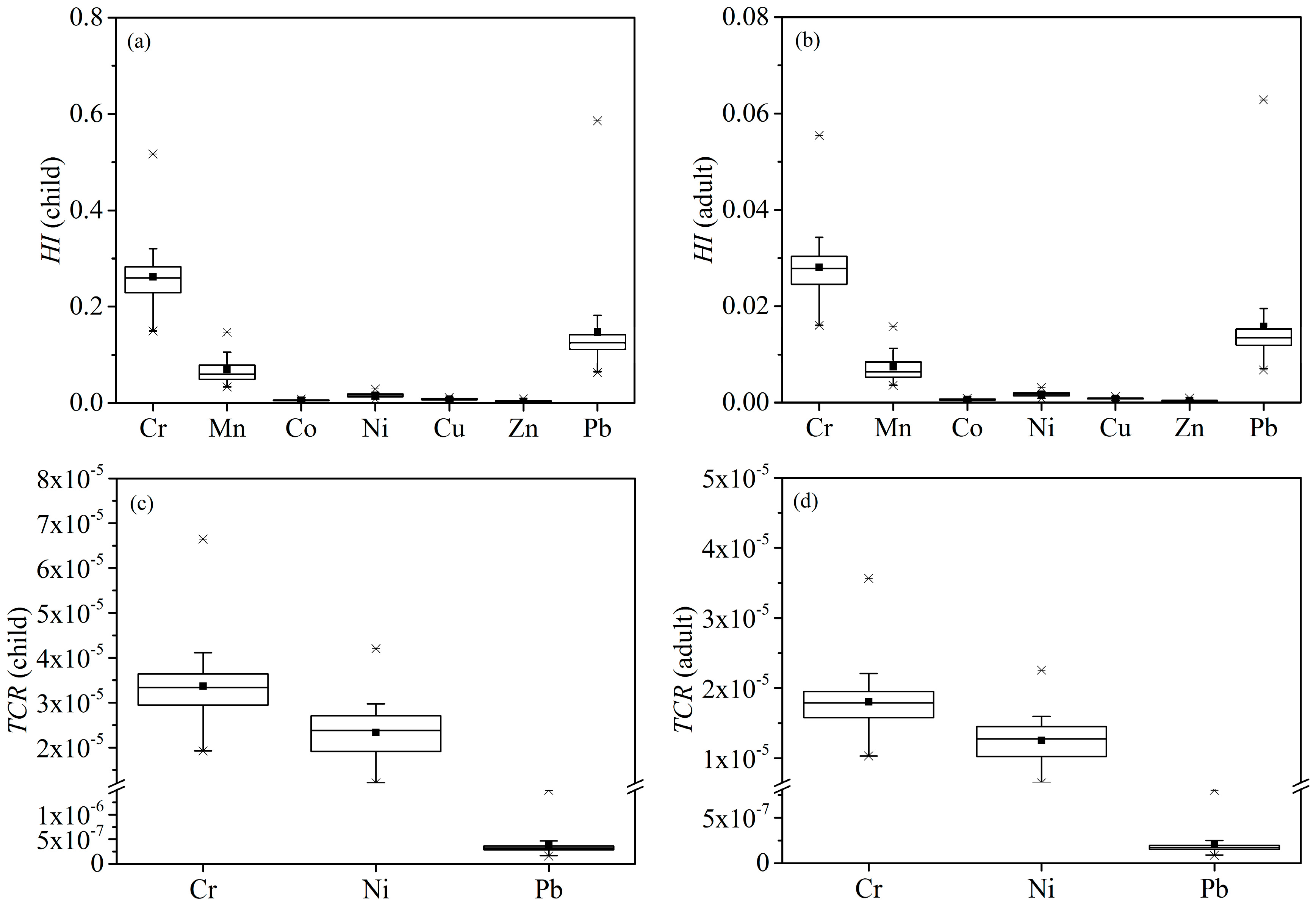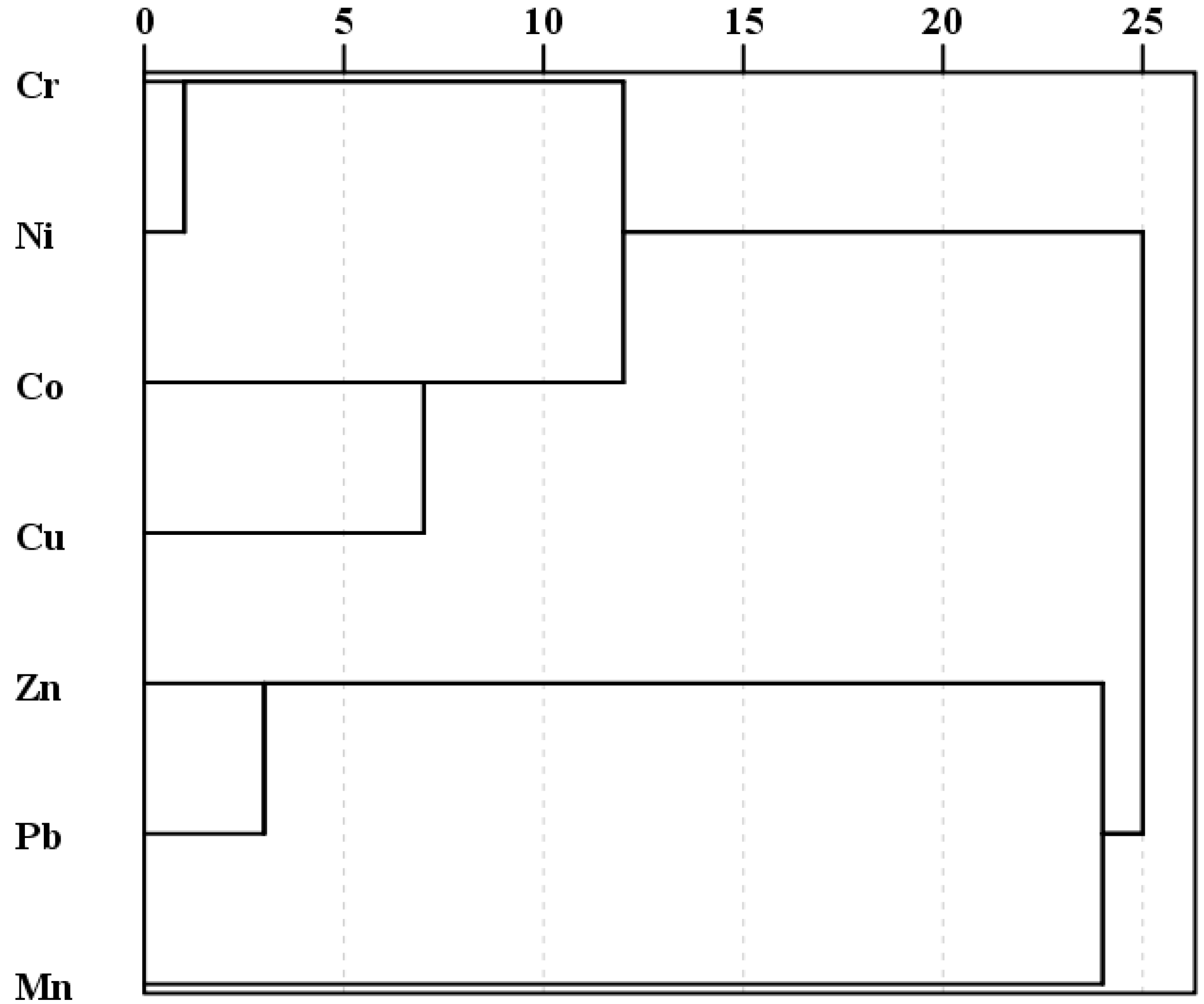Contamination Evaluation and Source Identification of Heavy Metals in the Sediments from the Lishui River Watershed, Southern China
Abstract
1. Introduction
2. Materials and Methods
2.1. Background of Study Area
2.2. Sampling and Sample Preparation
2.3. Analytical Methods
2.4. Heavy Metal Concentration and Contamination Assessment
2.4.1. Contamination Factor
2.4.2. Pollution Load Index
2.4.3. Nemerow Multi-Factor Index
2.4.4. Potential Ecological Risk Index
2.5. Potential Human Health Risk
2.5.1. Non-Carcinogenic Risk
2.5.2. Carcinogenic Risk
2.6. Multivariate Analysis
3. Results and Discussion
3.1. Heavy Metal Concentration and Spatial Distribution
3.2. Heavy Metal Contamination Assessment
3.3. Identification of Pollution Sources
4. Conclusions
Author Contributions
Acknowledgments
Conflicts of Interest
References
- Salomons, W.; Stigliani, W.M. Biogeodynamics of Pollutants in Soils and Sediments; Springer: Berlin, Germany, 1995. [Google Scholar]
- Adams, W.J.; Kimerle, R.A.; Barnett, J.W., Jr. Sediment quality and aquatic life assessment. Environ. Sci. Technol. 1992, 26, 1864–1875. [Google Scholar] [CrossRef]
- Ikem, A.; Egiebor, N.O.; Nyavor, K. Trace Elements in Water, Fish and Sediment from Tuskegee Lake, Southeastern USA. Water Air Soil Pollut. 2003, 149, 51–75. [Google Scholar] [CrossRef]
- Zheng, B.; Lu, S.; Wu, J.; Guo, X.; Wu, F.; Li, X.; He, Q.; Fu, Z.; Xu, L. Heavy metal distribution in Tiaoxi River’s sediment. Environ. Sci. Pollut. Res. 2018, 25, 2603–2613. [Google Scholar] [CrossRef] [PubMed]
- Zhuang, Q.; Li, G.; Liu, Z. Distribution, source and pollution level of heavy metals in river sediments from South China. Catena 2018, 170, 386–396. [Google Scholar] [CrossRef]
- Keshavarzi, B.; Mokhtarzadeh, Z.; Moore, F.; RastegariMehr, M.; Lahijanzadeh, A.; Rostami, S.; Kaabi, H. Heavy metals and polycyclic aromatic hydrocarbons in surface sediments of Karoon River, Khuzestan Province, Iran. Environ. Sci. Pollut. Res. 2015, 22, 19077–19092. [Google Scholar] [CrossRef] [PubMed]
- Liu, J.; Liu, Y.J.; Liu, Y.; Liu, Z.; Zhang, A.N. Quantitative contributions of the major sources of heavy metals in soils to ecosystem and human health risks: A case study of Yulin, China. Ecotoxicol. Environ. Saf. 2018, 164, 261–269. [Google Scholar] [CrossRef] [PubMed]
- Kusin, F.M.; Azani, N.N.M.; Hasan, S.N.M.S.; Sulong, N.A. Distribution of heavy metals and metalloid in surface sediments of heavily-mined area for bauxite ore in Pengerang, Malaysia and associated risk assessment. Catena 2018, 165, 454–464. [Google Scholar] [CrossRef]
- Ramachandra, T.V.; Sudarshan, P.B.; Mahesh, M.K.; Vinay, S. Spatial patterns of heavy metal accumulation in sediments and macrophytes of Bellandur wetland, Bangalore. J. Environ. Manag. 2018, 206, 1204–1210. [Google Scholar] [CrossRef] [PubMed]
- Wang, X.; Gu, Y.; Wang, Z.; Ke, C.; Mo, M. Biological risk assessment of heavy metals in sediments and health risk assessment in bivalve mollusks from Kaozhouyang Bay, South China. Mar. Pollut. Bull. 2018, 133, 312–319. [Google Scholar] [CrossRef] [PubMed]
- Hu, D. Studies on the Rainfall Characteristics and the Agricultural Water Resource Utilization in the Lishui River Basin; Hunan Agricultural University: Changsha, Hunan, China, 2009; Volume 69. (In Chinese) [Google Scholar]
- Qi, H.; Chen, W.; Lan, W. A study on the assessment of resources and economy and the model of development in the mid-lower valley of Lishui River. J. Changde Teach. Univ. (Soc. Sci. Ed.) 2001, 26, 57–59. (In Chinese) [Google Scholar]
- Guo, Y.; Mo, D.; Mao, L.; Jin, Y.; Guo, W.; Mudie, P.J. Settlement distribution and its relationship with environmental changes from the Paleolithic to Shang–Zhou period in Liyang Plain, China. Quat. Int. 2014, 321, 29–36. [Google Scholar] [CrossRef]
- Zeng, D.; Peng, B.; Zhang, K.; Fang, X.; Tan, C.; Kuang, X.; Wu, B.; Tu, X. Characteristics and assessment of heavy metal contamination in bed sediments from inlet areas of the Lishui River to Dongting Lake. Acta Sci. Circumst. 2017, 37, 3480–3488. (In Chinese) [Google Scholar]
- Zhang, G.; Huang, B. Health risk assessment of heavy metals in Dongting Lake water system in Hunan Province, China. Water Resour. Prot. 2014, 6, 41–71. (In Chinese) [Google Scholar]
- Li, F.; Huang, J.; Zeng, G.; Yuan, X.; Li, X.; Liang, J.; Wang, X.; Tang, X.; Bai, B. Spatial risk assessment and sources identification of heavy metals in surface sediments from the Dongting Lake, Middle China. J. Geochem. Explor. 2013, 132, 75–83. [Google Scholar] [CrossRef]
- Mo, J.; Xia, W.; Luo, Y. Analysis of soil erosion and soil conservation measures in Lishui River basin. Anhui Agric. Sci. Bull. 2009, 15, 75–76. (In Chinese) [Google Scholar]
- Du, Y.; Cai, S.; Zhang, X.; Zhao, Y. Interpretation of the environmental change of Dongting Lake, middle reach of Yangtze River, China, by 210 Pb measurement and satellite image analysis. Geomorphology 2001, 41, 171–181. [Google Scholar] [CrossRef]
- Li, J. Analysis of hydrological characteristics in Lishui River basin. J. Nat. Sci. Hun. Norm. Univ. 1991, 14, 267–272. (In Chinese) [Google Scholar]
- Xiao, L.; Yan, D. Thoughts and Suggestions on integrated resource management and development and utilization of Xiangjiang, Zishui, Yuanjiang and Lishui River. Water Resour. Plan. Des. 2008, 3–6. (In Chinese) [Google Scholar]
- Mao, L.; Mo, D.; Guo, Y.; Fu, Q.; Yang, J.; Jia, Y. Multivariate analysis of heavy metals in surface sediments from lower reaches of the Xiangjiang River, southern China. Environ. Earth Sci. 2013, 69, 765–771. [Google Scholar] [CrossRef]
- Song, Y.; Ji, J.; Yang, Z.; Yuan, X.; Mao, C.; Frost, R.L.; Ayoko, G.A. Geochemical behavior assessment and apportionment of heavy metal contaminants in the bottom sediments of lower reach of Changjiang River. Catena 2011, 85, 73–81. [Google Scholar] [CrossRef]
- Dai, L.; Wang, L.; Li, L.; Liang, T.; Zhang, Y.; Ma, C.; Xing, B. Multivariate geostatistical analysis and source identification of heavy metals in the sediment of Poyang Lake in China. Sci. Total Environ. 2018, 621, 1433–1444. [Google Scholar] [CrossRef] [PubMed]
- Hakanson, L. An ecological risk index for aquatic pollution control: A sediment ecological approach. Water Res. 1980, 14, 975–1001. [Google Scholar] [CrossRef]
- CNEMC (China National Environmental Monitoring Center). The Background Concentrations of Soil Elements in China; China Environmental Science Press: Beijing, China, 1990. (In Chinese) [Google Scholar]
- Tomlinson, D.L.; Wilson, J.G.; Harris, C.R.; Jeffrey, D.W. Problems in the assessment of heavy-metal levels in estuaries and the formation of a pollution index. Helgoländer Meeresuntersuchungen 1980, 33, 566–575. [Google Scholar] [CrossRef]
- Nemerow, N.L. Stream, Lake, Estuary, and Ocean Pollution; Van Nostrand Reinhold: New York, NY, USA, 1991. [Google Scholar]
- Yan, N.; Liu, W.; Xie, H.; Gao, L.; Han, Y.; Wang, M.; Li, H. Distribution and assessment of heavy metals in the surface sediment of Yellow River, China. J. Environ. Sci. China 2016, 39, 45–51. [Google Scholar] [CrossRef]
- Kolluru, R.V.; Bartell, S.M.; Pitblado, R.M.; Stricoff, R.S. Risk Assessment and Management Handbook; McGrow-Hill: New York, NY, USA, 1996. [Google Scholar]
- NRC (National Research Council); NAS (National Academy of Sciences). Risk Assessment in the Federal Government: Managing the Process; National Academy Press: Washington, DC, USA, 1983. [Google Scholar]
- US EPA. Risk Assessment Guidance for Superfund Volume 1 Human Health Evaluation Manual (Part A); Office of Emergency and Remedial Response: Washington, DC, USA, 1989.
- US EPA. Supplemental Guidance for Developing Soil Screening Levels for Superfund Sites; Office of Emergency and Remedial Response: Washington, DC, USA, 2002.
- US EPA. Integrated Risk Information System of the US Environmental Protection Agency; Office of Emergency and Remedial Response: Washington, DC, USA, 2012.
- Li, X.; Liu, L.; Wang, Y.; Luo, G.; Chen, X.; Yang, X.; Hall, M.H.P.; Guo, R.; Wang, H.; Cui, J.; et al. Heavy metal contamination of urban soil in an old industrial city (Shenyang) in Northeast China. Geoderma 2013, 192, 50–58. [Google Scholar] [CrossRef]
- Lu, X.; Wang, L.; Li, L.Y.; Lei, K.; Huang, L.; Kang, D. Multivariate statistical analysis of heavy metals in street dust of Baoji, NW China. J. Hazard. Mater. 2010, 173, 744–749. [Google Scholar] [CrossRef]
- Zhang, Z.; Lu, Y.; Li, H.; Tu, Y.; Liu, B.; Yang, Z. Assessment of heavy metal contamination, distribution and source identification in the sediments from the Zijiang River, China. Sci. Total Environ. 2018, 645, 235–243. [Google Scholar] [CrossRef]
- Chai, L.; Li, H.; Yang, Z.; Min, X.; Liao, Q.; Liu, Y.; Men, S.; Yan, Y.; Xu, J. Heavy metals and metalloids in the surface sediments of the Xiangjiang River, Hunan, China: Distribution, contamination, and ecological risk assessment. Environ. Sci. Pollut. Res. 2017, 24, 874–885. [Google Scholar] [CrossRef]
- Malvandi, H. Preliminary evaluation of heavy metal contamination in the Zarrin-Gol River sediments, Iran. Mar. Pollut. Bull. 2017, 117, 547–553. [Google Scholar] [CrossRef]
- Rodríguez-Espinosa, P.F.; Shruti, V.C.; Jonathan, M.P.; Martinez-Tavera, E. Metal concentrations and their potential ecological risks in fluvial sediments of Atoyac River basin, Central Mexico: Volcanic and anthropogenic influences. Ecotoxicol. Environ. Saf. 2018, 148, 1020–1033. [Google Scholar] [CrossRef]
- Green-Ruiz, C.; Paez-Osuna, F. Heavy metal anomalies in lagoon sediments related to intensive agriculture in Altata-Ensenada del Pabellon coastal system (SE Gulf of California). Environ. Int. 2001, 26, 265–273. [Google Scholar] [CrossRef]
- Abbasi, S.A.; Abbasi, N.; Soni, R. Heavy Metals in the Environment; Oscar Publication: St. Albans, UK, 2005. [Google Scholar]
- Zhu, Z.; Xu, G. Investigation on pollution control of breeding industry in Jinshi County. Prim Agric. Technol. Ext. 2016, 4, 89–90. (In Chinese) [Google Scholar]
- Liang, J. Study on Prehistoric Agriculture in Liyang Plain Located Dongting Lake Area; South China Agricultural University: Guangzhou, Guangdong, China, 2006. (In Chinese) [Google Scholar]
- Pignata, M.L.; Gudiño, G.L.; Wannaz, E.D.; Plá, R.R.; González, C.M.; Carreras, H.A.; Orellana, L. Atmospheric quality and distribution of heavy metals in Argentina employing Tillandsia capillaris as a biomonitor. Environ. Pollut. 2002, 120, 59–68. [Google Scholar] [CrossRef]
- Li, A. Mining-induced earthquake in Lishui River basin. South China J. Seismol. 2010, 30, 105–112. (In Chinese) [Google Scholar]
- Tong, T. Element concentrations in river delta sediments and mineral resources potential in the drainage basin: A case study in the Xiangjiang, Zishui, Yuanjiang, and Lishui rivers basins. Quant. Sci. 2005, 25, 298–305. (In Chinese) [Google Scholar]
- Men, C.; Liu, R.; Xu, F.; Wang, Q.; Guo, L.; Shen, Z. Pollution characteristics, risk assessment, and source apportionment of heavy metals in road dust in Beijing, China. Sci. Total Environ. 2018, 612, 138–147. [Google Scholar] [CrossRef]






| CF | Contamination Degree | RI | Potential Ecological Risk | |
|---|---|---|---|---|
| CFi < 1 | Low | < 40 | RI < 150 | Low |
| 1 ≤ CFi < 3 | Moderate | 40 ≤ < 80 | 150 ≤ RI < 300 | Moderate |
| 3 ≤ CFi < 6 | Considerable | 80 ≤ < 160 | 300 ≤ RI < 600 | Considerable |
| CFi ≥ 6 | Very high | 160 ≤ < 320 | High | |
| ≥ 320 | RI ≥ 600 | Very high |
| Parameter | Value |
|---|---|
| IR | Child: 200 mg/day; adult: 100 mg/day |
| CF | 1 × 10−6 kg/mg |
| FI | 1.0 |
| EF | 350 days/year |
| ED | Child: 6 years; adult: 30 years |
| BW | Child: 15 kg; adult: 70 kg |
| AT | Non-carcinogenic: ED × 365 days/years; carcinogenic: 70 years × 365 days/years |
| SA | Child: 2800 cm2; adult: 5700 cm2 |
| AF | Child: 0.2; adult: 0.07 |
| ABS | 0.001 |
| EF | 1 events/day × 350 days/year |
| Name of the River, Country | Heavy Metal Concentrations (mg/kg) | References | ||||||
|---|---|---|---|---|---|---|---|---|
| Cr | Mn | Co | Ni | Cu | Zn | Pb | ||
| Lishui River, China | 61.20 | 757.15 | 9.39 | 25.31 | 22.84 | 91.66 | 40.19 | This study |
| Zishui River, China | 67.51 | 1322.89 | 16.76 | 34.66 | 34.19 | 141.90 | 35.68 | [36] |
| Xiangjiang River, China | 120.44 | 1805.17 | 23.19 | 57.14 | 101.36 | 443.32 | 214.91 | [37] |
| Rivers in Guangdong Province, China | 21.81 | 325.78 | 4.58 | 15.99 | 15.71 | 60.16 | 26.93 | [5] |
| Zarrin-Gol River, Iran | 37.67 | 286.28 | 8.79 | 12.39 | - | 32.68 | - | [38] |
| Zahuapan River, Mexico | 121.63 | 293.88 | 8.25 | 19.38 | 12.63 | 91.63 | 9.00 | [39] |
| Atoyac River, Mexico | 181.83 | 158.17 | 5.33 | 22.00 | 14.17 | 62.17 | 12.17 | [39] |
| Background value | 71.30 | 459.00 | 14.60 | 31.90 | 27.30 | 94.40 | 29.70 | [25] |
| Heavy Metal | Cr | Mn | Co | Ni | Cu | Zn | Pb |
|---|---|---|---|---|---|---|---|
| Cr | 1 | ||||||
| Mn | 0.233 | 1 | |||||
| Co | 0.569 ** | 0.674 ** | 1 | ||||
| Ni | 0.906 ** | 0.259 | 0.707 ** | 1 | |||
| Cu | 0.627 ** | 0.283 | 0.769 ** | 0.725 ** | 1 | ||
| Zn | 0.193 | 0.417 | 0.414 | 0.258 | 0.442 * | 1 | |
| Pb | 0.243 | 0.34 | 0.423 | 0.233 | 0.476 * | 0.841 ** | 1 |
© 2019 by the authors. Licensee MDPI, Basel, Switzerland. This article is an open access article distributed under the terms and conditions of the Creative Commons Attribution (CC BY) license (http://creativecommons.org/licenses/by/4.0/).
Share and Cite
Shen, F.; Mao, L.; Sun, R.; Du, J.; Tan, Z.; Ding, M. Contamination Evaluation and Source Identification of Heavy Metals in the Sediments from the Lishui River Watershed, Southern China. Int. J. Environ. Res. Public Health 2019, 16, 336. https://doi.org/10.3390/ijerph16030336
Shen F, Mao L, Sun R, Du J, Tan Z, Ding M. Contamination Evaluation and Source Identification of Heavy Metals in the Sediments from the Lishui River Watershed, Southern China. International Journal of Environmental Research and Public Health. 2019; 16(3):336. https://doi.org/10.3390/ijerph16030336
Chicago/Turabian StyleShen, Fang, Longjiang Mao, Runxia Sun, Jijing Du, Zhihai Tan, and Min Ding. 2019. "Contamination Evaluation and Source Identification of Heavy Metals in the Sediments from the Lishui River Watershed, Southern China" International Journal of Environmental Research and Public Health 16, no. 3: 336. https://doi.org/10.3390/ijerph16030336
APA StyleShen, F., Mao, L., Sun, R., Du, J., Tan, Z., & Ding, M. (2019). Contamination Evaluation and Source Identification of Heavy Metals in the Sediments from the Lishui River Watershed, Southern China. International Journal of Environmental Research and Public Health, 16(3), 336. https://doi.org/10.3390/ijerph16030336




